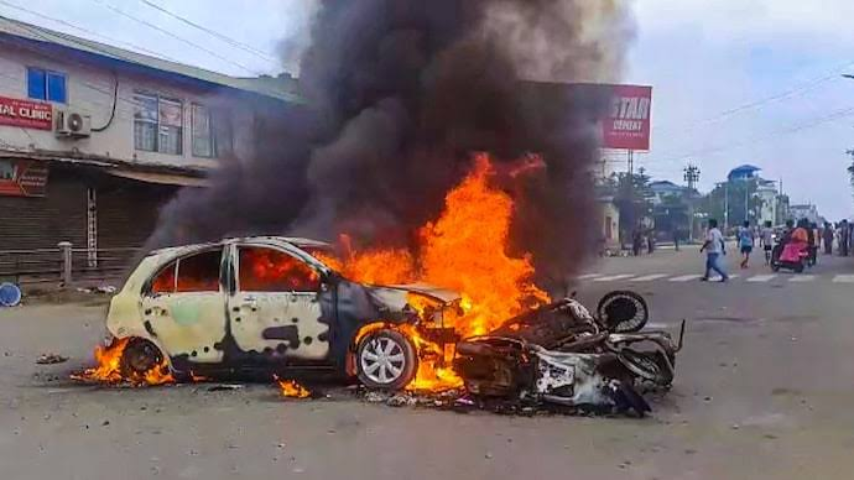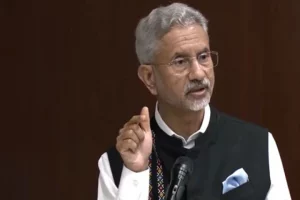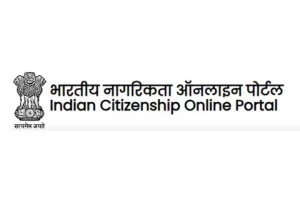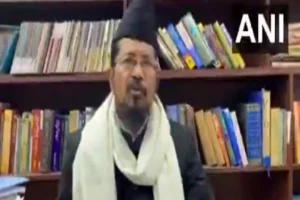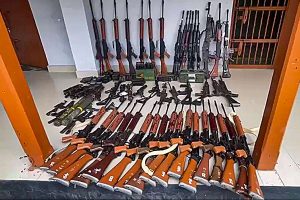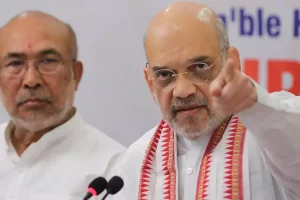The deeply concerning violence in Manipur, which had escalated in recent weeks, started with several journalists being targeted. On July 19, two journalists were assaulted by a group of men from the Kuki tribe, while they were reporting on a protest in Imphal.
The men reportedly accused the journalists of being “biased” in their coverage of the protest. This is not the first time that journalists have been targeted in Manipur, which has become a complex breeding ground for violence, Christian radicalization and Kuki demand for separate state.
In May, a video of two women being paraded naked went viral, sparking widespread outrage. Several journalists who reported on the video were threatened and harassed. Apart from the serious threat to press freedom, there have been reports of widespread violence in Manipur. In recent weeks, there have been clashes between armed groups, resulting in the deaths of several people. There have also been reports of arson and looting.
Is this really an indigenous civil struggle or a civil disobedience pattern gaslighted with political motives during upcoming parliamentary elections?
Let us examine these disturbances in Manipur one by one. Someone has cleverly sparked hostility between two ethnic groups– the tribal Kuki of the hills and the majority Meitei of the valleys in Manipur. The Kuki community consists of refugees from Myanmar and adjoining areas, and are not indigenous mainland Indians. But due to Scheduled Tribe status, they have enjoyed more rights than the majority, original Indian ethnic group -the Meitei.
Temporary shelter homes are being constructed for displaced Meitei families whose houses were burnt by Kukis in Manipur's Thoubal district.
Kashmiri Pandits 2.0 pic.twitter.com/FFJuJpLLcx
— Sunanda Roy 👑 (@SaffronSunanda) July 23, 2023
As obviously expected, the latter began to demand ST status too. The clashes started when the Kuki, who are not even original Indians, started solidarity marches against the original Meitei’s demand for ST status. The marches started turning into ugly clashes. Fake videos were circulated of Kuki’s dishonoured Meitei women, leading to escalation of violence and the horrific ‘Naked Parade’ as an act of revenge by the Meitei’s. But the point to wonder is, when the Kukis were already secured by the Govt of India, despite them being ‘outsiders’ in mainland India, despite Indians not favourable to accepting Refugees, then why did they have to start opposing the original inhabitants?
Their opposition led to increased hostility. Politically motivated persons have clearly taken advantage of this situation. While one half of the critics blame Biren Singh, the BJP chief minister of Manipur, for stoking violence by instigating Meitei’s, another half blames elements from BJP’s opposition, for instigating the Kukis against the majority. The latter seems conceivable, as we have seen how the Indian left wing has never sympathized but often weaponized issues, especially by setting in motion, the gullible and oft violent ‘refugees’ and ‘minority Muslims’ into action against BJP govt or its supporters.
The riots instigated against Abrogation of Article 370, CAA, Farm Laws, Requirement of Public Property from Encroachers or Uniform Civil Code, the inhuman killing of BJP workers in West Bengal and Kashmir, are all blaring examples. The dissent almost always comes from Indian left wing IT cell, consisting of unidentifiable twitter accounts, unreliable fact checkers, insurgents, drug dealers and weapons dealers, especially from refugee communities like Rohingyas, Bangladeshis or Pakistani settlers in Kashmir, and never from the authentic Indian majority- the honest, tax paying, ‘originals,’ whether Hindus or original Muslims of the soil. This time another ‘outsider’ community, the Kukis, were targeted by the Indian left wing to unleash dissent and consequent unrest in the largely peaceful Manipur, to create an image of ‘Unrest under BJP.’
This is not merely a speculation but a verifiable fact, given that India’s chief investigation agency CBI, was stopped from conducting searches, in connection with weapons procurement, by clashing tribes in Manipur. The Kuki’s demand for a separate state in India has come as a shocking surprise for the majority in the state. A classic case of separatism, being demanded by refugees from economically failed nations, in a secular democracy, is not new for the world.
RH Raising, a politician from India’s North Eastern state Nagaland, stated quite vocally, “A people cannot imagine politics without land. Refugees, nomadic people, and immigrants do not have politics of their own. Of course, they may be granted members of a political community or citizenship of a country they migrated to. But launching a political movement by a group of refugees or immigrants for a separate homeland or a separate State in other people’s country is an act of aggression on the inherent right of the native people and their land.”
His statement may be brushed off as harshly insensitive but the element of truth in it cannot be denied. Any land whose indigenous people get marginalized and preferential rights are given to immigrants, is bound to witness widespread dissent and unrest.
India has been vulnerable to illegal immigrants since its foundation in 1947. In recent years, the issue of illegal immigration has become increasingly complex. There are an estimated 5 million to 10 million illegal immigrants living in India, and the government has been struggling to deal with the problem. One of the biggest challenges is that India is not a signatory to the 1951 UN Convention relating to the Status of Refugees. This means that there is no clear legal framework for dealing with refugees, and the government must rely on a patchwork of laws and regulations.
Another challenge is that the government does not have a clear way of identifying illegal immigrants. Many illegal immigrants have forged documents, and it can be difficult to distinguish them from legal residents. The government has taken some steps to address the issue of illegal immigration. In 2017, the government launched a National Register of Citizens (NRC) in Assam, which is aimed at identifying illegal immigrants from Bangladesh. As expected, the toxic Indian left wing has successfully made the topic of NRC a controversial one, and it has been challenged in court.
The government has also announced plans to deport illegal immigrants, but it is unclear how this will be implemented. Deportation is a complex and expensive process, and it is not clear how the government will identify and track down illegal immigrants.
The issue of illegal immigration is a complex one, leading to a myriad of problems including resource encroachments, thefts, inflation, endangerment to local culture, threat to safety and security of local women, clashes with indigenous people, law and order problems since migrants do not have the same level of emotional connect with public property in a country as its local indigenous people do.
Just this week, Rohingya refugees pelted stones at Indian police personnel in Jammu. In May 2021, 5 illegal Bangladeshi immigrants have been held in Bengaluru for rape and assault of a woman. In Oct 2022, Assamese people raised objections that their Muslim settlers from Bangladesh were stealing their cultural heritage by setting up their own museums, allegedly funded by Al Qaeda money. Pakistani illegal immigrants easily found their way into Kashmir through porous borders and settled down comfortably in the majority Muslim region, using their Muslim names to advantage, and slowly turning the Kashmiri Muslims against their own bloodline- the Kashmiri Pandits and the rest of India. Abdul Qadeer Khan from Peshawar Pakistan, delivered the first toxic speech to Kashmiri Muslims, instigating them against the Maharaja of Kashmir, he is quoted as saying” let us raze the palace to ground, we have plenty of stones.” This is how the tradition of ‘stone pelting’ started in Kashmir, patronized by the Pakistan funded proxy Tehreek-e-Hurriyat, led by Lahore educated SAS Geelani.
It is high time, that the government of India finds a way to address the issue of illegal immigration, to protect its indigenous citizens. India is turning into the only country in the world, whose majority is being marginalized and are fighting for equal rights in their own country.
The Manipur violence and Kuki calls for freedom, the resentment of Indians towards Rohingyas getting flats to live in while many Indians are homeless, Bangladeshi origin people forcing Bengali origin Hindus out of their homes in rural West Bengal, Assamese people feeling restless as their culture is getting crushed by unwelcome immigrants, and Indian defence system struggling to keep Pakistan out of its porous Kashmir borders, is a clear indication of India’s weak fault line – the problem of illegal immigrants. And during every parliamentary election, the Indian left wing connives with this faultline, causing mayhem and distress in the lives of India’s helpless majority.






